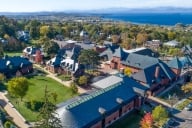You have /5 articles left.
Sign up for a free account or log in.
A feeling of curiosity pushed me to visit the imposing building of the School Museum in Ljubljana, Slovenia, where I am spending a month on research leave. I wanted to go in and see what was inside, as I was grappling with two questions 1) What was school like in Slovenia 100 years ago? and 2) How was this history presented for today’s public?
My first impression was that school was not that much different in Slovenia in comparison with other places I am acquainted with. One of the obvious reasons for this was the fact that at the beginning, Slovenian public education was subsumed to the Vienna-made rules in the matter, since the country was at the time part of the Austro-Hungarian empire. Thus, images of classrooms with strictly aligned desks, screwed to the floor in pairs, with a blackboard covered with traces of chalk are not only typically Slovene but could be coming from anywhere in Europe.
This points to the great integration (read, uniformity) of school systems in Europe at the time. In design, but not only: the pedagogic principles that guided the teaching were the same, and so were the social structures that allowed access for some and not for others. This school system promoted, like its contemporaries in France, Britain or elsewhere in Europe, segregation of sexes, segregation of classes and a very restrictive access to schooling. Moreover, the authority of the teacher was enshrined symbolically by the geography of the classroom (he, almost invariably a male in the late 1800s, was positioned on a podium elevated above the classroom floor), and by the practices of discipline (physical punishment was the norm – something not explicitly mentioned in the museum).
Classroom in the museum
The museum highlights the chronological evolution of didactics and of the school environment, but more than anything the exhibition focuses on the national element. In other words, the story presented is about the becoming of the Slovene nation, a process in which the school has played a central role. It was in school that a sense of common belonging was created, with the gradual introduction study not only in German (the language of the Empire) but also in Slovenian, and of subjects like Slovenian literature or Slovenian geography. Since this is a young state (independent for the first time only since 1991), the national development narrative connects the more distant past with contemporary debates.
In this sense, both my first and second questions were answered in a way to strengthen my feeling that politics and education have always walked hand in hand (and continue to do so even today). From the ruling ideas about how and who to teach (which changed with the spirit of the times from exclusive and hierarchical to more inclusive and flat), to the very content of the education (the sharper focus on national elements) everything was/is political.
I was wondering in a previous post whether politics may have a place in the classroom. This visit at the museum added evidence to the fact that politics already is there.
Anamaria writes from Lund, Sweden. She is one of the founding members of the editorial collective at University of Venus.








